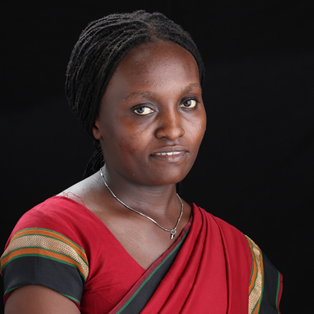GM crops have gene(s) inserted from the same or unrelated organism using genetic engineering methods, according to the UN Food and Agriculture Organisation (FAO).
These genes, FAO says, confer beneficial traits such as pest resistance, ability to grow in extreme and unfavourable conditions and increased nutrient levels among others.
Take an example of a GM cowpea (legume) variety resistant to Legume Pod Borer, one of the most damaging insect pests reducing cowpea production by up to 80 percent, according to the AATF, which led an international public-private partnership that developed the variety.
To develop the variety, scientists introduced into it a gene obtained from Bacillus thuringiensis (Bt), a soil bacterium that produces proteins which selectively kill the targeted insects without affecting other living organisms.
“The GM cowpea variety has helped tackle the legume insect pest, hence increasing cowpea production by 80 percent, and that is a lot of impact already,” Vitumbiko Chinoko, Open Forum on Agricultural Biotechnology (OFAB) Project Manager told The New Times last week.
OFAB is a project of the African Agricultural Technology Foundation (AATF).
He indicated that there are some GM crops being grown in a couple of countries in Africa. They include cotton in Malawi, Kenya, Ethiopia and Nigeria which is also growing [drought-resistant] GM maize, and cowpea.
He added that South Africa long ago adopted GM crops, and has been consuming GMO maize for over 20 years without any safety concern.
Evariste Tugirinshuti, the president of the Federation of Maize Farmers’ Cooperatives in Rwanda told The New Times that drought was having a toll on maize production.
“Overall, maize production in 2022 farming season A (which ended in February 2022) dropped by about 30 per cent because of drought,” he estimated.
“We need maize varieties that are resistant to drought,” he appealed.
Disease-resistant cassava and potato trials in Rwanda
Rwanda is carrying out confined field trials for a GM cassava variety believed to be resistant to cassava brown streak virus disease (CBSD), and cassava mosaic disease (CMD).
These are two major destructive diseases which threaten cassava production in the country, according to Athanase Nduwumuremyi, Coordinator of Roots and Tubers Program at Rwanda Agriculture and Animal Resources Development Board (RAB). Nduwumuremyi is also the coordinator of the OFAB Rwanda chapter.
“Currently, we intend to conduct the multilocation trials under CFT [confined field trial] to confirm how they perform in terms of yield and subsequent nutritional composition,” Nduwumuremyi told The New Times.
Cassava and [Irish] potato are among major staple food crops in Rwanda, with production estimated at over 1.3 million tonnes and 938 thousands tonnes respectively in 2021, according to data 2021 seasonal agricultural survey 2021 annual report by the National Institute of Statics of Rwanda.
In 2019, RAB announced that it was going to test a GM [Irish] potato variety, called Victoria, believed to be resistant to late blight, a destructive potato disease locally known as ‘Imvura’.
The variety was developed by the International Potato Centre (CIP) through inserting into the ordinary potato, the disease-resistant trait that scientists took from a wild potato.
According to information from CIP, late blight cost developing countries an estimated $10 billion in lost revenues through reduced yields.
Placide Rukundo, coordinator of Biotechnology Programme at RAB told The New Times that in June 2022, the Rwanda Environment Management Authority [REMA], which is in charge of biosafety regulation, provided an approval to RAB to conduct this potato variety research.
“If all requirement is set, this research can start in season 2023A. If the good GM potato varieties resistant to late blight and meeting the end-users’ preferences are found, the cost of production would be reduced (no cost of fungicides and labour for spraying), and environmental pollution would be reduced,” he said.
Tackling hunger in Africa
Africa is the region with the highest hunger prevalence in the world, with 278 million people on the continent – or 20.2 percent of its population – being hungry in 2021 [from 257 million individuals in 2018], according to the State of Food Security and Nutrition in the World 2022 by FAO.
Yet the continent had a target to end hunger by 2025, according to the 2014 Malabo Declaration through the Comprehensive Africa Agriculture Development Programme (CAADP).
Vitumbiko said that this hunger situation in Africa can be explained in terms of climate change, because of the rising population or the escalation of pests and diseases.
“We have GM technologies that can help arrest the pests and diseases that are escalating because of climate change, we have technologies that can help us produce more, thereby really meeting the increasing demand for food in view of the increasing population,” he said.
Safety assurance
According to the International Service for the Acquisition of Agri-biotech Applications (ISAAA), in 2019, the 24th year of commercialisation of biotech crops (GM crops), 190.4 million hectares of biotech crops were planted by up to 17 million farmers in 29 countries across the world.
It indicated that GM crop farmers were reaping higher yield with reduced use of pesticides and better management of weeds among other benefits.
The World Health Organisation (WHO) indicated that GM foods currently available on the international market have passed safety assessments and are not likely to present risks for human health.
“In addition, no effects on human health have been shown as a result of the consumption of such foods by the general population in the countries where they have been approved,” says WHO.
This article was originally written by Emmanuel Ntirenganya and published by the New Times Rwanda.



















































































